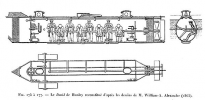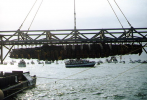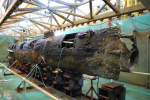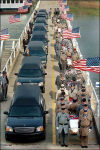JR49
Respected Leader
Arvasinhan minä, että noilla ratkesi.Etelävaltioiden sukellusvene H.L. Hunley.
Kaikkien uskottavien sukellusvenekokoomateosten oleellinen osa on kertomus H.L. Hunleyn hyökkäyksestä USS Housatonicia vastaan. Jännittävästi aivan viime vuosiin asti ollut erilaisia teorioita sukellusveneen tuhoutumisen syistä. Nyt on tullut uutta tietoa, mikä ansaitsee tulla esille.
Katosi onnistuneen hyökkäyksen jälkeen 1864, nostettiin vuonna 2000 ja tutkimuksia miehistön jäänteiden ja aluksen kanssa on jatkettu siitä pitäen.
https://en.wikipedia.org/wiki/H._L._Hunley_(submarine)
Kuka ei ole tähän kertomukseen perehtynyt, niin lukusuositus. Ainakin kahdeksan kilometriä matkanneet veivaten alusta eteenpäin lihasvoimalla, tavoitteena iskeä tankotorpedolla vihollisalusta kylkeen. Eli parhaassakin tapauksessa kohtuulähellä jysähtää räjähde. Lisäksi tulee muistaa, että vapaaehtoisia riitti, vaikka H.L Hunley oli uponnut kahdesti tappaen edellisest miehistöt... Kovia jätkiä

Upon removal of the silt inside the hull, the skeletons of the crewmembers were found seated at their stations, with no signs of skeletal trauma.[21] In October 2008, scientists reported they had found that the crew of Hunley had not set her pump to remove water from the crew's compartment, and this might indicate she was not flooded until after they died. In January 2013, it was announced that conservator Paul Mardikian had found evidence of a copper sleeve at the end of Hunley's spar. This finding indicated the torpedo had been attached directly to the spar, meaning the submarine may have been less than 16 feet (5 m) from Housatonic when the torpedo exploded.[3][22] In 2018, researchers reported that the keel blocks, which the crew could release from inside the vessel to allow the sub to surface quickly in an emergency, had never been released.[23]
The short distance between the torpedo and the vessel, in addition to the signs that the crew died instantaneously and without a struggle to survive, led a team of blast trauma specialists from Duke University to theorize that the Hunley's crew was killed by the blast itself,[12] which could have transmitted pressure waves inside the vessel without damaging its hull. Their research, which included scaled experiments with live black powder bombs, provided data indicating the crew was likely killed by the explosion of their own torpedo, which could have caused immediate pulmonary blast trauma.
Tässä miehistöluettelo:
The crew was composed of Lieutenant George E. Dixon (Commander) (of Alabama or Ohio), Frank Collins (of Virginia), Joseph F. Ridgaway (of Maryland), James A. Wicks (North Carolina native living in Florida), Arnold Becker (of Germany), Corporal Johan Frederik Carlsen (of Denmark), C. Lumpkin (probably of the British Isles), and Augustus Miller (probably a former member of the German Artillery).
Jumalaton kampi on tietenkin sukellusveneen moottori. Lihasvoimalla toiminut.

Tässä se nousee haudastaan


Ja tässä luettavaa päälliköstä ja kultakolikosta:
https://en.wikipedia.org/wiki/George_E._Dixon
Tässä taas hautajaisista vuonna 2004. Ne olivat todelliset sotasankareiden arvoiset. 136 vuoden jälkeen tehtävä saadaan päätökseen.
https://www.hunley.org/hunley-crew-burial/

Huomatkaa liput arkkujen päällä. Onneksi tämä tapahtui ennen BLM-mellakoita. Tämäkin kunniakas tapahtuma olisi pilattu roskajoukon toimesta ja noista urheista miehistä olisi leivottu jonkin sortin rasisteja tms.
@Erkki , areena on sinun.
